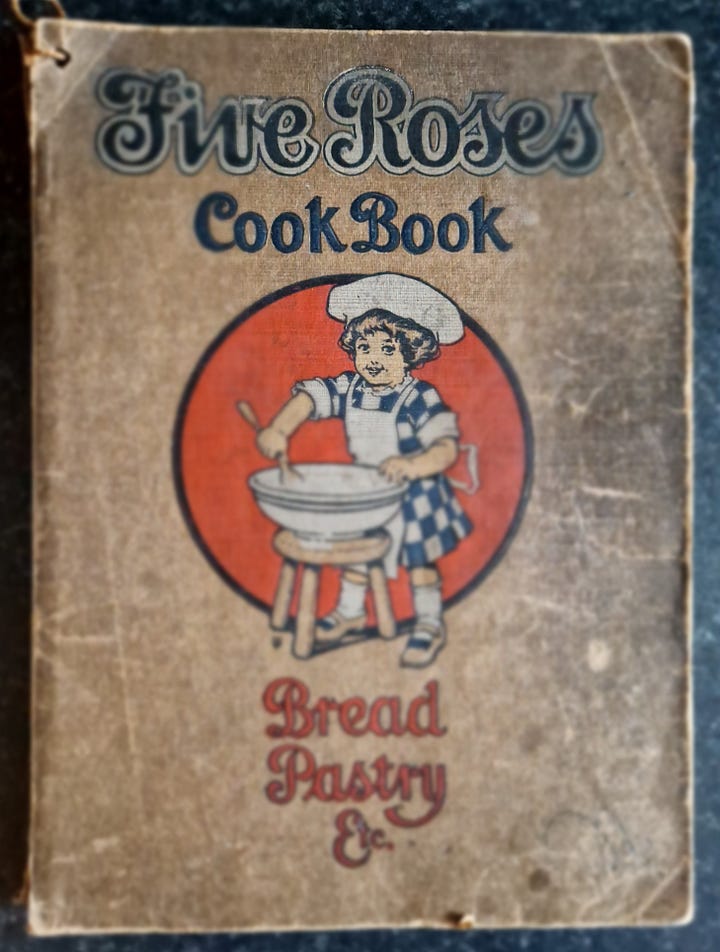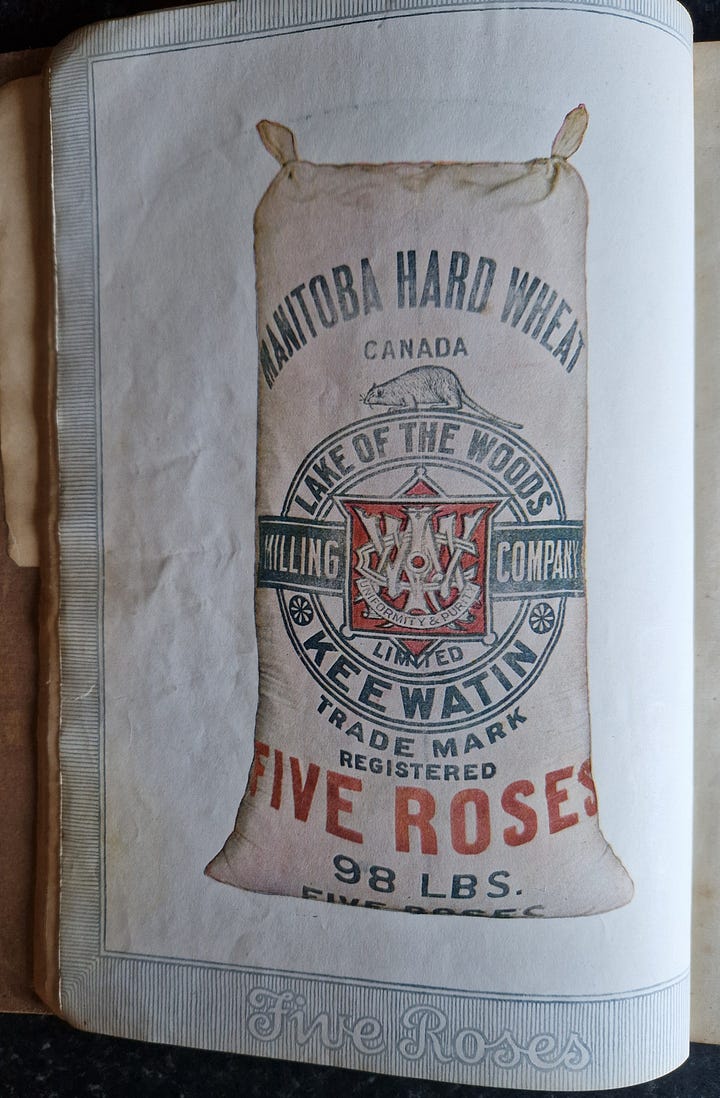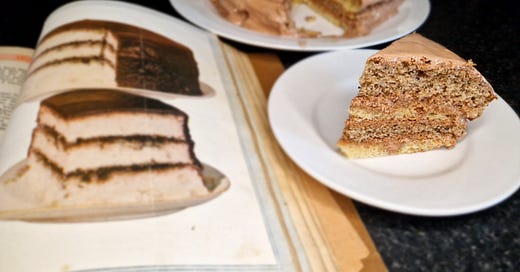In 1919 one of my ancestors came back to England from Canada to visit her family, with her she brought the Five Roses Cookbook, which she left behind (I assume as a gift). This cookbook has been passed down through my family for the last 100 years. Flicking through this book I have often been drawn to one of the colour plates and was intrigued by a recipe entitled "Hilda's Chocolate Cake (The Most Delicious I ever ate)". It is a most unusual chocolate cake and as you can see has a colour image for guidance (well if the image was actually like the cake). However my attempt at baking this cake did not quite go according to the recipe. Question is was it the most delicious chocolate cake I have ever eaten?

Apart from the family history associated with this recipe book, it is also a fascinating source of social history. It was published in 1915 by the Lake of the Woods Milling Company of Montreal, who were the manufacturer’s of Five Roses Flour. Five Roses flour was first produced in 1888 at Keewatin, Canada and is still produced today.
To quote the Five Roses website:
“For generations, Five Roses flour has been putting smiles on the faces of Canadians by delivering delicious and reliable results.”
This is not that different from the claims made in the 1915 recipe book.
“Five Roses is the favorite in one million Canadian homes, not because it makes the most bread per sack or the best bread, but because it is steady, regular, dependable.”
This cookery book was a promotional item and as far as I am aware was available for 20c, or what seems to be the cost of postage, from the company. At the very front of the book is a page stating how you can get more copies of it for friends and family by sending a coupon which “must be properly filled out in every particular and the silver (20c) or stamps duly enclosed to cover postage.” In my particular copy all the coupons are missing so I assume they were used at the time.


The promotional nature of this recipe book is clear throughout as every few pages there are statements about the quality and reliability of the flour. There are illustrations and even colour plates of sacks and barrels of Five Roses flour. There are statements reinforcing how good the quality of the flour and it’s hygienic nature. In the nineteenth century, adulteration of flour with substances such as chalk, alum and plaster of Paris was a major issue. These still would have been concerns in 1915, so Five Roses was clearly leaning into this issue to promote its brand.
On the title page the book describes itself as
Being a Manual of Good Recipes carefully chosen from the contributions of over two thousand successful users of Five Roses Flour throughout Canada. Also useful notes on the various classes of good things to eat, all of which have been carefully checked and re-rechecked by competent authority.
This may answer the question of “who is Hilda?”, as in the name of the cake recipe. She was probably one of the many to enter their recipes for inclusion in the book. This seems to be the only recipe with a name attribution in the title, although I have not managed to look at every one of the 500 plus recipes in the book. It also seems to be the only one with a recommendation under it. I am assuming that the “competent authority” that is mentioned on the title page is the one responsible for the “best ever cake” recommendation. This does make me wonder if Hilda was actually known to this person, rather than just a random recipe sent into to the company.
The book has some useful tips on weight and measures (which I probably should have looked at more closely), making bread and how to make “dainty” sandwiches, along with other useful tips. It also has personal recommendations for Five Roses flour entitled “What your own Friends and Neighbours say about Five Roses Flour”. These are filled with the expected, ‘I’ve been using Five Roses for 10 or 20 years and it’s the best flour ever.’ However some give an insight into life at the time. There’s one from a 17 year old who states that as the oldest of 10 she has to be the cook. One of my favourites states that since coming to Alberta they have only used Five Roses flour and “it is known as the best in the West”.
What else I find fascinating about this book are the colour plates, which appear to be colour lithographs. There are quite a few throughout the book, including for Hilda’s chocolate cake recipe. This 1915 edition of the Five Roses Cook Book was actually the second edition, the first being published in 1913, however it was the first with colour images.
As you can see from the photograph above the picture in the recipe book does not exactly match what I produced by following the recipe. Two things are very apparent, and not due to any problems I had with the recipe. Firstly the cake in the image is only three layers but the recipe states to make four. The recipe also calls for two layers of the cake to be a plain vanilla cake but the other two are flavoured with allspice, mace and a small amount of chocolate, hence they look and taste a bit like ginger or carrot cake. The reality does not really match the picture in the book, now and in the past, which is confusing now and possibly them. Maybe expectations of images matching the recipe where not as high in 1915 as they are today.
One of the joys of old recipes is the fact that often the instructions are not as clear as recipe books today. On first appearance this recipe book seems to have fairly clear instructions and ingredient lists. I did have to translate all the measurements from US/Canadian cups to grams. I did this before I realised there was a section on measurements at the front of the book, which converts everything into ounces. This would have saved me some time. I do wonder if that was also for a British audience as well. The book was published during World War I and Canada was a major supplier of flour to Britain before and during the war. The Imperial War Museum has references to Canada gifting 10,000 sacks of flour to Britain in 1917, but I could not find references to what was happening in 1915 with reference
In the recipe it also says to add 4 eggs (beaten separately). I took this to mean adding each egg one at a time but it really meant separate the yolks and egg whites, then beat the add whites before adding. This is not really mentioned until you get to the method, which says “add gradually the whites of the eggs which have been beaten dry and stiff”. A lesson in reading the method before proceeding with the recipe. This method is usually used for a genoise sponge as the primary leavening method, by incorporating the air into the cake batter. This probably would have made my version of the chocolate cake more fluffy. However this cake recipe, unlike a genoise, also had baking power in it, so my cake did rise.
The filling and frosting on this cake is also quite unusual. The recipe calls for unsweetened chocolate. The only unsweetened chocolate I could find was 100% cacao so this may account for why my cake is much paler than the pictures. I would make it again with a good dark chocolate in the cake and cocoa powder in the frosting to get a darker chocolate colour.
The frosting uses an Italian meringue method with egg whites and sugar syrup. Personally I had only used this method once before for a Italian meringue buttercream. Hilda’s recipe calls for adding the cream of tartar, which acts as a stabiliser for the meringue, to the sugar syrup, however more modern recipes add it to the egg whites. I do not know if this would affect the stability but my meringue was perfect until it came to adding the chocolate. The recipe states to add grated chocolate to the meringue, however once I did this it collapsed and became runny. Adding the chocolate at this point removes the air from the meringue. The chocolate should have been added to the meringue when it was being beaten to maintain it’s structure. So my frosting and filling was quite runny and when I put it between the layers it soaked into the sponge. This made it very moist and quite delicious but not quite the outcome suggested in the image from the recipe book. However once I covered the outside of the cake with the frosting and put it in the fridge, apart from the colour, it had a similar look and texture to that in the colour plate. So I am not sure if the meringue was meant to become runny or remain fluffy.
Was this cake the most delicious chocolate cake I had ever eaten? I would say it was delicious, if a little unusual with its combination of spices and chocolate. It was very sweet and the layers became a bit too moist. So I can’t quite agree with the statement in the recipe book. I do want to retry this recipe using the correct method for the sponge and adjusting the method of the frosting so it is fluffy rather than runny. Maybe then this cake can claim the most delicious title once again.
References
Lake of the Woods Milling Company, “Five Roses Cook Book,” Bruce Peel Special Collections Library Online Exhibits, accessed February 26, 2025, https://omeka.library.ualberta.ca/items/show/1533.






What a lovely recipe and part of Canadian food history. 👍👍
I got to try this cake was very different but nice to try. Please try some more. Great article. Best wishes pat